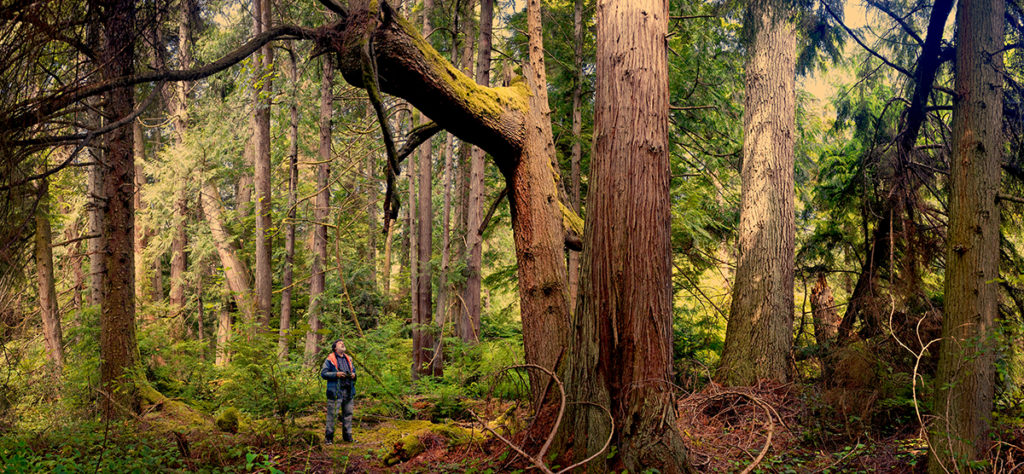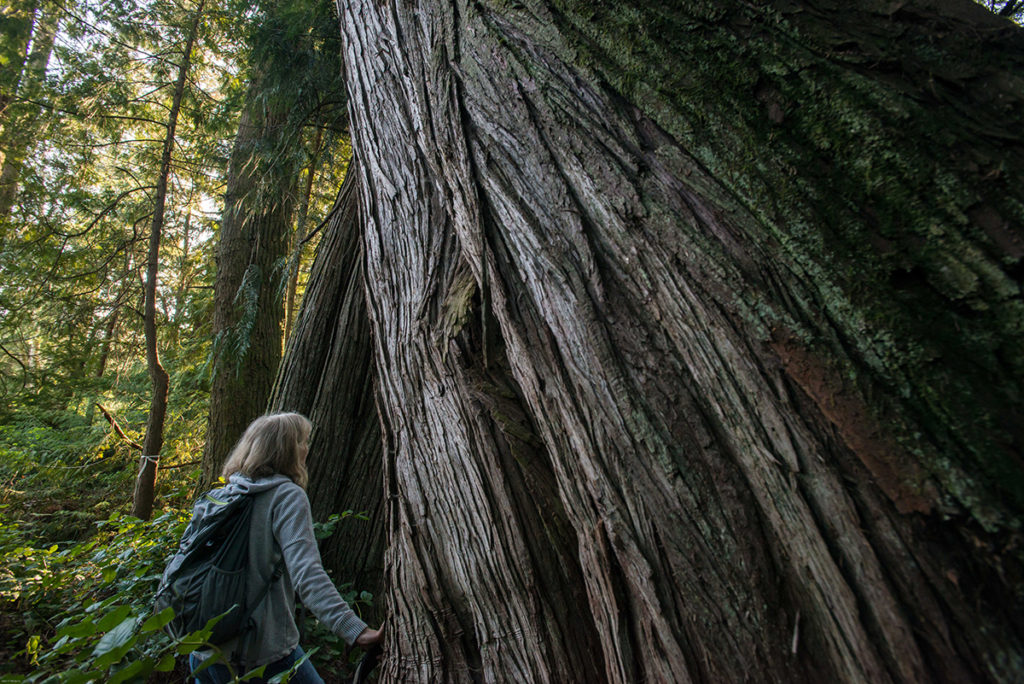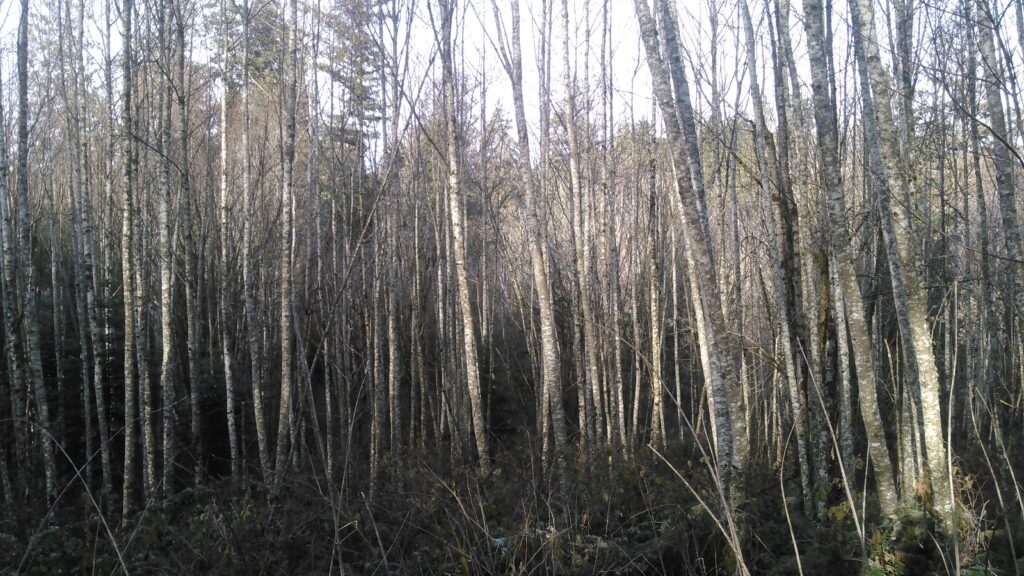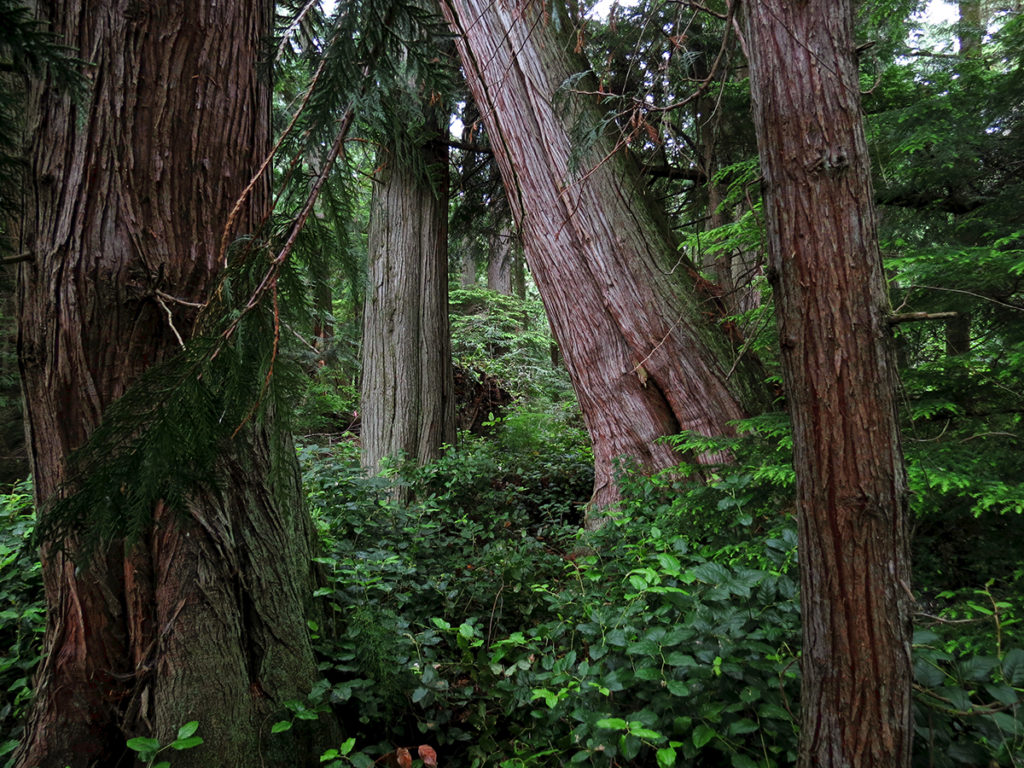This Forest on the Kitsap is Protected – Forever

Photo credit: Joe Walsh.
On Washington’s Kitsap Peninsula – that arrow-shaped piece of land between Puget Sound and the Olympic Peninsula – Great Peninsula Conservancy is working to conserve and restore degraded shorelines, peat bogs, forests, saltwater marshes, and salmon-bearing streams.
The lands and waters under Great Peninsula Conservancy’s care are protected – forever. Through property purchases and conservation easements, the land trust is safeguarding more than 10,500 acres of ecologically important areas on the Kitsap Peninsula.
“The rapidity of residential and urban development in the Kitsap Peninsula makes it so important to set aside sites for the future,” says Adrian Wolf, Stewardship Manager for the Conservancy. NNRG has been working with Conservancy staff to develop management plans for many of their properties and gain Forest Stewardship Council® (FSC®) certification for nearly 500 acres of forest.
Many of the Conservancy’s land acquisitions aren’t open to the public, as they act as refuges for species on both state and federal endangered species lists. But eight properties comprising over 800 acres of the peninsula do have public access and are either FSC®-certified or on their way to obtaining certification. Grovers Creek Preserve is one such property.

Grovers Creek Preserve is at the center of a forest corridor of nearly 1,700 acres spanning the Kitsap Peninsula. To the east lies Kitsap County’s North Kitsap Heritage Park, and to the west is the Port Gamble Forest Heritage Park. Together, these conservation properties conserve a significant open space corridor and protect land critical to the Sound to Olympics Trail, which someday will connect the Mountains to Sound Greenway Trail with the Olympic Discovery Trail.
The 197-acre preserve near Poulsbo was once industrial timberland. The forest was replanted with Douglas-fir after the last clearcut logging by the previous owner in 1998, but the young firs were quickly outcompeted by red alder. Since Douglas-fir is not shade tolerant, it succumbed to the increasingly dense hardwood canopy, and by the time the Conservancy acquired the property and hired NNRG to write its management plan in 2015, only a handful of anemic and shade-weary fir remained, struggling to persist amongst the alder.

NNRG Director of Forestry Kirk Hanson worked with the Conservancy to develop a forest management plan that established goals for the property. A short-term priority was controlling and removing invasive species. And in the long-term, the Conservancy aims to foster a mature, diverse native forest that supports high-value wildlife habitat, diverse biota, clean water and carbon sequestration.
“The management plan calls for some forest thinning projects, which we began in 2013,” says Erik Pedersen, Conservation Easement Specialist for the Conservancy. “We’ve started pecking away at that work as resources allow, and there’s a larger thinning project on the horizon for Grover’s Creek.” Accompanying the thinning work, the Conservancy is engaging in snags, den trees and coarse woody debris enhancement actions for wildlife habitat which is supported by the United States Department of Agriculture’s Natural Resource Conservation Service Conservation Stewardship Program.
Since the preserve is FSC®-certified through NNRG’s FSC® group certificate, any active management will adhere to FSC® standards. “When we do active management in the Preserve, being certified is one way of communicating to the public that we’re holding ourselves to the highest standards there are,” says Pedersen.

Grover Creek Preserve boasts 60 acres of rare older growth forest, including stands of 200-year-old Sitka spruce, redcedar, hemlock, and fir which the Conservancy hopes will attract endangered marbled murrelets searching for large branches on which to deposit their egg. The preserve even has 11.5 acres of late successional forested peat bog.
Protected for all time, Grovers Creek Preserve provides a place for locals and visitors to observe and experience a forest that is being thoughtfully restored and protected for generations of humans and wildlife to come.
The Conservancy is developing a walking trail system at the Preserve, but for now visitors can enjoy a more rustic stroll through a closed canopy forest. Adrian offers interested visitors to “walk through the preserve and notice changes as we implement ecologically-appropriate forest management actions to accelerate the development of older forests and functions”. Check greatpeninsula.org for updates on the trail system.
Photo credit: Joe Walsh.
On Washington’s Kitsap Peninsula – that arrow-shaped piece of land between Puget Sound and the Olympic Peninsula – Great Peninsula Conservancy is working to conserve and restore degraded shorelines, peat bogs, forests, saltwater marshes, and salmon-bearing streams.
The lands and waters under Great Peninsula Conservancy’s care are protected – forever. Through property purchases and conservation easements, the land trust is safeguarding more than 10,500 acres of ecologically important areas on the Kitsap Peninsula.
“The rapidity of residential and urban development in the Kitsap Peninsula makes it so important to set aside sites for the future,” says Adrian Wolf, Stewardship Manager for the Conservancy. NNRG has been working with Conservancy staff to develop management plans for many of their properties and gain Forest Stewardship Council® (FSC®) certification for nearly 500 acres of forest.
Many of the Conservancy’s land acquisitions aren’t open to the public, as they act as refuges for species on both state and federal endangered species lists. But eight properties comprising over 800 acres of the peninsula do have public access and are either FSC®-certified or on their way to obtaining certification. Grovers Creek Preserve is one such property.

Grovers Creek Preserve is at the center of a forest corridor of nearly 1,700 acres spanning the Kitsap Peninsula. To the east lies Kitsap County’s North Kitsap Heritage Park, and to the west is the Port Gamble Forest Heritage Park. Together, these conservation properties conserve a significant open space corridor and protect land critical to the Sound to Olympics Trail, which someday will connect the Mountains to Sound Greenway Trail with the Olympic Discovery Trail.
The 197-acre preserve near Poulsbo was once industrial timberland. The forest was replanted with Douglas-fir after the last clearcut logging by the previous owner in 1998, but the young firs were quickly outcompeted by red alder. Since Douglas-fir is not shade tolerant, it succumbed to the increasingly dense hardwood canopy, and by the time the Conservancy acquired the property and hired NNRG to write its management plan in 2015, only a handful of anemic and shade-weary fir remained, struggling to persist amongst the alder.

NNRG Director of Forestry Kirk Hanson worked with the Conservancy to develop a forest management plan that established goals for the property. A short-term priority was controlling and removing invasive species. And in the long-term, the Conservancy aims to foster a mature, diverse native forest that supports high-value wildlife habitat, diverse biota, clean water and carbon sequestration.
“The management plan calls for some forest thinning projects, which we began in 2013,” says Erik Pedersen, Conservation Easement Specialist for the Conservancy. “We’ve started pecking away at that work as resources allow, and there’s a larger thinning project on the horizon for Grover’s Creek.” Accompanying the thinning work, the Conservancy is engaging in snags, den trees and coarse woody debris enhancement actions for wildlife habitat which is supported by the United States Department of Agriculture’s Natural Resource Conservation Service Conservation Stewardship Program.
Since the preserve is FSC®-certified through NNRG’s FSC® group certificate, any active management will adhere to FSC® standards. “When we do active management in the Preserve, being certified is one way of communicating to the public that we’re holding ourselves to the highest standards there are,” says Pedersen.

Grover Creek Preserve boasts 60 acres of rare older growth forest, including stands of 200-year-old Sitka spruce, redcedar, hemlock, and fir which the Conservancy hopes will attract endangered marbled murrelets searching for large branches on which to deposit their egg. The preserve even has 11.5 acres of late successional forested peat bog.
Protected for all time, Grovers Creek Preserve provides a place for locals and visitors to observe and experience a forest that is being thoughtfully restored and protected for generations of humans and wildlife to come.
The Conservancy is developing a walking trail system at the Preserve, but for now visitors can enjoy a more rustic stroll through a closed canopy forest. Adrian offers interested visitors to “walk through the preserve and notice changes as we implement ecologically-appropriate forest management actions to accelerate the development of older forests and functions”. Check greatpeninsula.org for updates on the trail system.

Leave a Reply